Klein Tools NCVT-1XT Handleiding
Klein Tools
Meetapparatuur
NCVT-1XT
Bekijk gratis de handleiding van Klein Tools NCVT-1XT (4 pagina’s), behorend tot de categorie Meetapparatuur. Deze gids werd als nuttig beoordeeld door 44 mensen en kreeg gemiddeld 4.1 sterren uit 22.5 reviews. Heb je een vraag over Klein Tools NCVT-1XT of wil je andere gebruikers van dit product iets vragen? Stel een vraag
Pagina 1/4

•
Non-contact detection of 70 to 1000V AC in cables, cords, circuit breakers, lighting xtures, switches, outlets, and
wires
•
When voltage is detected, a high intensity, bright Red LED illuminates and a beeping sound is generated
•
Detección sin contacto de 70V a 1000V CA en cables, cables conductores, cortacircuitos, accesorios de iluminación
interruptores, tomacorrientes y alambres
•
Cuando se detecta tensión, se enciende un potente LED de color rojo brillante yse oye un indicador sonoro
•
Détection sans contact de la tension de 70 à 1000Vc.a. dans les câbles, les cordons, les disjoncteurs, les luminaires, les
interrupteurs, les prises et les fils
•
Signal sonore et voyant DEL rouge à haute intensité qui signalent lorsqu’une tension est détectée
NCVT-1XT
INSTRUCTIONS – Non-Contact Voltage Tester (English: Page 2)
INSTRUCCIONES – Probador de voltaje sin contacto (Español: página 3)
INSTRUCTIONS – Testeur de tension sans contact (Français : page 4)
3
9
4
1
2
5
7
6
8
ENGLISH
1.Power On / Off Button
2.Power On / Low Battery Indicator
3.Voltage Detection LEDs (Inside Tip)
4.Non-Contact Tip
5.Pocket Clip
6.O-ring Seal
7.Battery Cap
8.2x AAA Batteries (Included)
9.Keep hand and fingers below this line
while using tester
NOTE: There are no user-serviceable
parts inside tester.
1.
Botón de encendido y apagado "NCV"
2. Indicador de encendido y batería baja
3. LED de detección de voltaje
(en el interior de la punta)
4. Punta para detección y
medición sin contacto
5. Clip de bolsillo
6. Junta tórica
7. Tapa del compartimento de baterías
8. 2baterías AAA (incluidas)
9.Mantenga la mano y los dedos debajo
deesta línea mientras usa el probador
ESPAÑOL
NOTA: El probador no contiene
en su interior piezas que el
usuario pueda reparar.
1. Bouton marche/arrêt NCV
(test de tension sans contact)
2. Voyant de mise sous tension/
piles faibles
3. VoyantsDEL de détection de
tension(dans la pointe)
4. Pointe sans contact
5. Agrafe pour poche
6. Joint torique
7. Couvercle de piles
8. 2pilesAAA (comprises)
9.Gardez la main et les doigts sous
cetteligne pendant l'utilisation
FRANÇAIS
REMARQUE: Ce testeur
ne contient aucune pièce
réparable par l’utilisateur.
FIG. 1
SYMBOLS ON TESTER / SÍMBOLOS DEL PROBADOR / SYMBOLES SUR LE TESTEUR
Warning – Risk of electric shock / Advertencia: riesgo de choque eléctrico / Avertissement – Risque d'électrocution
Risk of danger. It is important that users of this tester read, understand, and follow all warnings, cautions, safety information, and Important information:
instructions in this manual before operating or servicing this tester. Failure to follow instructions could result in death or serious injury.
Riesgo de peligro. Es importante que el usuario de este probador lea, comprenda y respete todas las advertencias, precauciones, Información importante:
instrucciones e información de seguridad incluidas en este manual, antes de poner en funcionamiento el probador o de realizarle servicios de mantenimiento.
No seguir estas instrucciones puede dar lugar a lesiones graves o mortales.
Risque de danger. Il est important que les utilisateurs de ce testeur lisent, comprennent et suivent tous les avertissements, mises Information importante:
en garde, informations de sécurité et instructions donnés dans le présent guide avant de faire fonctionner ou de réparer ce testeur. Le non-respect pourrait
entraîner des blessures graves, voire la mort.
Double insulated / Doble aislamiento / Double isolation Read instructions / Lea las instrucciones / Lire les instructions
Conformité Européenne:
Conforms with European Economic Area directives.
Cumple con las normas del Área Económica Europea.
Conforme aux directives de l’Espace économique Européen.
UKCA:
UK Conformity Assessment
Conformidad evaluada porelReino Unido
Évaluation de la conformité du Royaume-Uni
This product has been independently tested by Intertek and meets applicable published standards.
Este producto p1-ha sido probado de manera independiente por Intertek y cumple con las normas publicadas vigentes.
Ce produit a été testé de manière indépendante par Intertek et répond aux exigences des normes applicables.
CAT
IV
For measurements performed at the source of low-voltage installation and outside lines.
Para mediciones realizadas en la fuente de la instalación de bajo voltaje y líneas externas.
Pour des mesures prises à la source d’une installation à faible tension et des lignes extérieures.
DURABILITY / DURABILIDAD / DURABILITÉ
Ingress Protection
Protección contra el ingreso
Protection contre les infiltrations
IP67
Drop Protection
Protección ante caídas
Protection contre les chutes
9.8 ft.
(3 m)
Safety Rating
Clasificación de seguridad
Cote de sécurité
CAT IV
1000V
BASED ON: 1330974 Rev 04/22 B
5001748

ENGLISH
WARNINGS
To ensure safe operation and service of the tester, follow these
instructions. Failure to observe these warnings can result in severe
injury or death.
•
Risk of electric shock and burn. Contact with live circuits could result in death
or serious injury
•
Use caution with voltages above 25V AC as a shock hazard may exist
•
A blinking LED or a steadily illuminated LED in the tip and audible beeps
indicate presence of voltage. If no indication, voltage could still be present
•
Before and after each use, verify operation by testing a known working circui
that is within the rating of this unit
•
Never assume neutral or ground wires are de-energized. Neutrals in multi
wire branch circuits may be energized when disconnected and must b
retested before handling
•
The tester
WILL NOT
detect voltage if
•
The wire is shielded
•
The operator is not grounded or is otherwise isolated from an effective
earth ground
•
The voltage is DC
•
The tester
MAY NOT
detect voltage if
•
The user is not holding the tester
•
The user is insulated from the tester with a glove or other materials
•
The wire is partially buried or in a grounded metal conduit
•
The tester is at a distance from the voltage source
•
The field created by the voltage source is being blocked, dampened, o
otherwise interfered with
•
The frequency of the voltage is not a perfect sine wave between 50 and
500Hz.
•
The tester is outside of operating conditions (listed in Specifications
section)
•
Operation may be affected by differences in socket design and insulation
thickness and type; tester may not be compatible with some types of standard
or tamper resistant (TR) electrical outlets
•
In bright light conditions, the LED visual indicators will be less visible
•
When powered-ON, one of the “power-ON” LED’s will be illuminated, and a
green light will illuminate the tip
DO NOT USE TESTER UNLESS ONE OF THE
“POWER-ON” LED
s
IS ILLUMINATED.
•
Do not use if tester appears damaged or is not operating properly. If in doubt
replace the tester
•
Do not apply more than the rated voltage as marked on the tester (1000V)
•
Do not apply to uninsulated hazardous live conductors
•
Detection above 70V AC is specified under "normal" conditions as detailed
below. The tester may detect at a different threshold at different conditions, o
may not detect at all unless
•
The tip of the tester is within 0.25" (6 mm) of an AC voltage source radiating
unimpeded
•
The user is holding the body of the tester with his or her bare hand
•
The user is standing on or connected to earth ground
•
The air humidity is nominal (50% relative humidity – non-condensing)
•
The tester is held still
•
Always wear approved eye protection.
•
Comply with local and national safety requirements
•
If this product is used in a manner not specified by the manufacturer
protection provided by the product may be affected
OPERATING INSTRUCTIONS
CHECKING FOR THE PRESENCE OF AC VOLTAGE
1. Press the Power On / Off button. After performing a self-test, a
green LED
3
will illuminate the tip when no voltage is detected.
2. Prior to use, test on a known live circuit to verify tester
functionality.
3. Place tip of the tester
4
near AC voltage. If voltage is present,
the unit will emit audible beeps and the red LED
3
in the tip will
illuminate.
SILENT OPERATION
To activate silent operation, power-ON by pressing and holding the
NCV Power-ON button
1
for more than 2 seconds. Power-ON in this
manner each time silent operation is desired.
CLEANING
Be sure tester is turned off and wipe with a clean, dry lint-free
cloth.
Do not use abrasive cleaners or solvents.
STORAGE
Remove the batteries when not in use for a prolonged period
of time. Do not expose to high temperatures or humidity. After
a period of storage in extreme conditions exceeding the limits
mentioned in the General Specifications section, allow the tester to
return to normal operating conditions before using.
FCC AND IC COMPLIANCE
See this product’s page at www.kleintools.com for FCC compliance
information.
Canada ICES-003 (B) / NMB-003 (B)
DISPOSAL / RECYCLE
Do not place equipment and its accessories in the trash.
Items must be properly disposed of in accordance with local
regulations. Please see www.epa.gov recycle/ for additional
information.
CUSTOMER SERVICE
KLEIN TOOLS, INC.
450 Bond Street, Lincolnshire, IL 60069 1-800-553-4676
customerservice@kleintools.com www.kleintools.com
MAINTENANCE
BATTERY REPLACEMENT
When the battery is low, the unit will power-on with a blinking red
LED
2
. When this happens, the batteries must be replaced:
1. Unscrew the battery cap
7
and remove/recycle spent batteries.
2. Install two new AAA batteries. Note proper polarity.
3. Screw battery cap tightly to ensure a tight seal with the O-Ring
6
.
FUNCTION BUTTONS
NCV POWER ON/OFF BUTTON
1
Press and release the NCV Power button
1
. The tester will emit a
single beep, the Power On Indicator
2
and green LED
3
in the tip
will illuminate. To power-OFF the tester, press and release the Power
On / Off button
1
. The tester will emit a double beep.
NOTE: The tester will automatically power-OFF following 4 minutes of
inactivity to conserve battery life.
CAUTION
•
DO NOT
attempt to repair this tester. It contains no serviceable parts
•
DO NOT
expose tester to extremes in temperature or high humidity
GENERAL SPECIFICATIONS
The Klein Tools NCVT-1XT is a durable 70 to 1000V AC non-contact
voltage tester with IP67 rating and a 3m (9.8') drop protection.
• Environment: Indoor
• Measurement Range: 70 to 1000V AC
• Frequency Range: 50 to 500 Hz
• Batteries: 2x AAA 1.5V Alkaline
• Operating and Storage Altitude: Up to 6562 ft. (2000 m)
• Operating and Storage Temp: ° ° ° °14 to 122 F (-10 to 50 C)
• Relative Humidity: <95% non-condensing
• Dimensions: 5.34" x 1.08" x 0.97" (135.6 x 27.4 x 22.1 mm)
• Weight: 1.65 oz (46.7 g) with batteries
• Pollution degree: 2
• Safety Rating: CAT IV 1000V AC
• Drop Protection: 9.8 ft. (3 m)
• Ingress Protection: IP67
• Standards: EN61010-1:2010+A1: 2019,
EN IEC 61010-2-030:2021+A11:2021.
Conforms to UL STD. 61010-1, 61010-2-030
Certi ed to CSA STD. C22.2 No. 61010-1, 61010-2-030.
Specifications subject to change.
5001748

ESPAÑOL
ADVERTENCIAS
Para garantizar el funcionamiento y servicio seguros del probador,
sigaestas instrucciones. El incumplimiento de estas advertencias
puede provocar lesiones graves o la muerte.
•
Riesgo de choque eléctrico y quemaduras. El contacto con los circuitos activos
podría provocar la muerte o lesiones graves.
•
Tenga precaución con los voltajes superiores a 25VCA, p3-ya que podría exi
riesgo de choque eléctrico.
•
Un LED intermitente o fijo en la punta y la emisión de pitidos indican la presencia
de voltaje. Aun cuando el instrumento no lo indique, es posible que haya voltaje
•
Antes y después de cada uso, verifique el funcionamiento realizando una prueba
en un circuito activo que se encuentre dentro de la capacidad de esta unidad
•
Nunca suponga que los cables neutro y de puesta a tierra están desenergizados
Los neutros en circuitos derivados de cables de múltiples alambres pueden esta
energizados aunque estén desconectados y deben volver a probarse antesde
manipularlos.
•
El probador
NO
detectará voltaje en las siguientes situaciones
•
Si el cable está blindado.
•
Si el operador no está conectado a tierra o está aislado de alguna manera
deuna toma de tierra eficaz.
•
Si el voltaje es de CD.
•
El probador
POSIBLEMENTE NO
detecte voltaje en las siguientes situaciones
•
Si el usuario no sostiene el probador.
•
Si el usuario está aislado del probador mediante un guante u otro material
•
Si el cable está parcialmente enterrado o en un conducto de metal conectado
atierra.
•
Si el probador se encuentra a cierta distancia de la fuente de voltaje
•
Si el campo creado por la fuente de voltaje está bloqueado, amortiguado
osometido a interferencia de alguna otra manera.
•
Si la frecuencia de voltaje no es una onda sinusoidal perfecta entre 50 y 500Hz.
•
Si el probador se encuentra fuera de las condiciones de funcionamiento
(descritas en la sección Especificaciones)
•
El funcionamiento puede llegar a verse afectado por diferencias en el diseño
delenchufe y el tipo y grosor del aislamiento. Es posible que el probador no
seacompatible con algunos tipos de tomacorrientes estándar o inviolables.
•
En condiciones de mucha luz, los indicadores visuales LED serán menos visibles
•
Al encenderse la unidad, se iluminará uno de los LED de “encendido” y una luz
verde iluminará la punta.
NO UTILICE EL PROBADOR A MENOS QUE UNO DE
LOS LED DE “ENCENDIDO” ESTÉ ILUMINADO.
•
No use el probador si parece dañado o si no funciona correctamente. Si tiene
dudas, reemplace el probador
•
No aplique un voltaje nominal mayor al indicado en el probador (1000V).
•
No lo utilice en conductores activos peligrosos sin aislamiento
•
La detección de más de 70VCA en el modo1 o de más de 12V CA en e
modo2se especifica en condiciones “normales” como se indica a continuación.
El probador puede detectar voltaje en un umbral diferente, en diferentes
condiciones, o puede no detectar voltaje en absoluto a menos que
•
La punta del probador está dentro de 0,25" (6mm) de una fuente de voltaje
deCAque irradia sin impedimento.
•
El usuario sostiene el cuerpo del probador con la mano descubierta
•
El usuario está parado sobre una toma de tierra o conectado a ella
•
La humedad del aire es de valor nominal (50% de humedad relativa,
sincondensación)
•
El probador se sostiene firmemente para mantenerlo inmóvil.
•
Siempre debe usar protección para los ojos aprobada
•
Cumpla con los requisitos locales y nacionales de seguridad
•
Si este producto se usa de una manera contraria a lo especificado por el
fabricante, la protección proporcionada por el producto puede verse afectada.
INSTRUCCIONES DE FUNCIONAMIENTO
VERIFICACIÓN DE PRESENCIA DE VOLTAJE CA
1. Presione el botón de encendido y apagado. Después de realizar una
autoprueba, un LED verde
3
iluminará la punta cuando no se detecta
ningún voltaje.
2. Antes de utilizar el probador, realice pruebas en un circuito activo
paracomprobar que funcione correctamente.
3. Coloque la punta del probador
4
cerca del voltaje CA. Si se detecta
voltaje, la unidad emitirá pitidos y se encenderá el LED rojo
3
en
lapunta.
FUNCIONAMIENTO EN MODO SILENCIOSO
Para activar el modo silencioso, mantenga presionado el botón de
encendido NCV
1
durante más de 2segundos. Encienda el probador de
esta manera cada vez que desee hacerlo funcionar en modo silencioso.
LIMPIEZA
Asegúrese de que el probador esté apagado y límpielo con unpaño
limpio y seco que no deje pelusas.
No utilice solventes ni
limpiadores abrasivos.
ALMACENAMIENTO
Retire las baterías si no va a utilizar el instrumento durante un tiempo
prolongado. No lo exponga a la humedad ni a altas temperaturas. Luego
deun período de almacenamiento en condiciones extremas que sobrepasen
los límites mencionados en la sección Especificaciones generales, deje que
el probador vuelva a las condiciones de funcionamiento normales antes de
utilizarlo.
CONFORMIDAD CON LA NORMATIVA FCC/IC
Puede leer la información sobre la normativa FCC para este producto
enwww.kleintools.com.
ICES-003 (B)/NMB-003 (B) de Canadá
ELIMINACIÓN/RECICLAJE
No arroje el equipo ni sus accesorios a la basura. Los
elementos se deben desechar correctamente de acuerdo
con lasregulaciones locales. Para obtener más información,
consultewww.epa.gov recycle/ .
SERVICIO AL CLIENTE
KLEIN TOOLS, INC.
450 Bond Street, Lincolnshire, IL 60069 1-800-553-4676
customerservice@kleintools.com www.kleintools.com
MANTENIMIENTO
REEMPLAZO DE LAS BATERÍAS
Cuando la batería tiene poca carga, la unidad se enciende mostrando
un LED rojo intermitente
2
. Cuando esto ocurre, las baterías deben
reemplazarse:
1. Desenrosque la tapa del compartimiento de las baterías
7
y retire
yenvíe las baterías agotadas a reciclaje.
2. Instale dos baterías AAA nuevas. Tenga en cuenta la polaridad correcta.
3. Enrosque la tapa del compartimiento de las baterías firmemente para
garantizar un cierre estanco con la junta tórica
6
.
BOTONES DE FUNCIONES
BOTÓN DE ENCENDIDO Y APAGADO NCV
1
Presione y suelte el botón de encendido NCV
1
. El probador emitirá un
solo pitido y se encenderá el indicador de encendido
2
y el LED
3
verde
en la punta. Para apagar el probador, mantenga presione y suelte el botón
de encendido y apagado
1
. El probador emitirá dos pitidos.
NOTA: El probador se apagará automáticamente después de 4minutos
deinactividad para preservar la vida útil de las baterías.
PRECAUCIÓN
•
NO
intente reparar el probador. No contiene piezas que se puedan reparar.
•
NO
exponga el probador a condiciones de temperatura extrema o de
humedad alta
ESPECIFICACIONES GENERALES
El NCVT-1XT de Klein Tools es un probador de voltaje sin contacto
quedetecta de 70 a 1000V CA que cuenta con una clasificación IP67
yprotección ante caídas de 3m (9,8').
• Entorno: Interior
• Rango de medición: 70 a 1000VCA
• Rango de frecuencia: 50 a 500Hz
• Baterías: 2 baterías alcalinas AAA de 1,5V
• Altitud de funcionamiento y almacenamiento: hasta 6562' (2000m)
• Temperatura de funcionamiento y almacenamiento: °14 a 122 F
(-10a 50 C)°
• Humedad relativa: <95%, sin condensación
• Dimensiones: 5,34" × 1,08" × 0,97" (135,6 × 27,4 × 22,1mm)
• Peso: 1,65oz (46,7g) con baterías
• Grado de contaminación: 2
• Clasi cación de seguridad: CAT IV 1000V CA
• Protección ante caídas: 9,8' (3m)
• Protección de ingreso: IP67
• Normas: EN61010-1:2010+A1: 2019,
EN IEC 61010-2-030:2021+A11:2021.
Cumple con la norma UL. 61010-1, 61010-2-030
Certi cado según la norma. C22.2 n.º61010-1, 61010-2-030.
Especificaciones sujetas a cambios.
5001748
Product specificaties
| Merk: | Klein Tools |
| Categorie: | Meetapparatuur |
| Model: | NCVT-1XT |
Heb je hulp nodig?
Als je hulp nodig hebt met Klein Tools NCVT-1XT stel dan hieronder een vraag en andere gebruikers zullen je antwoorden
Handleiding Meetapparatuur Klein Tools
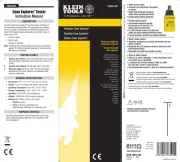
8 Juli 2025
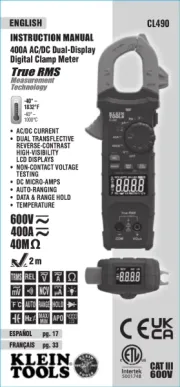
14 April 2025

13 Januari 2025

13 Januari 2025

18 November 2024

12 November 2024

24 September 2024

21 September 2024

21 September 2024

18 Juni 2024
Handleiding Meetapparatuur
- Kübler
- Eastron
- IKEA
- Silvercrest
- Werma
- Testboy
- Einhell
- Eltako
- Beckmann & Egle
- Goobay
- Lund
- Doyon
- GlowShift
- INFICON
- Bohle
Nieuwste handleidingen voor Meetapparatuur
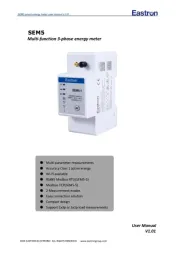
29 Juli 2025
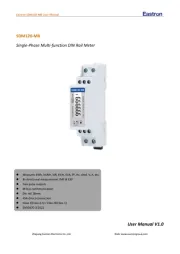
29 Juli 2025
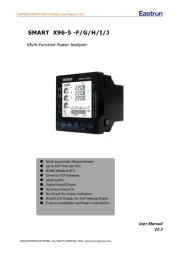
29 Juli 2025

29 Juli 2025
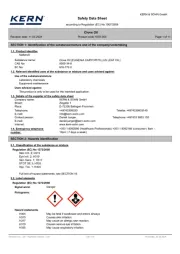
29 Juli 2025
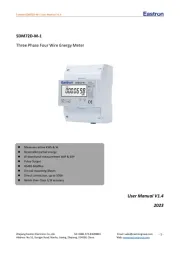
29 Juli 2025
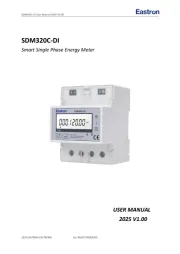
28 Juli 2025
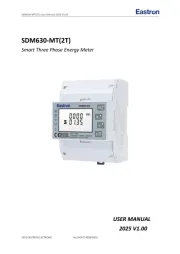
28 Juli 2025
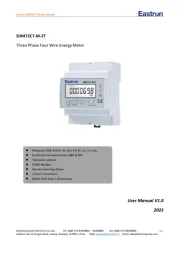
28 Juli 2025
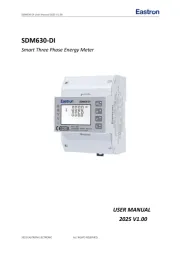
28 Juli 2025